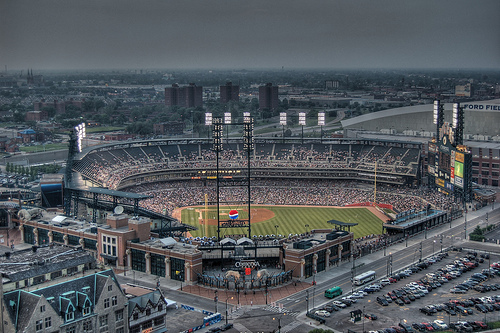Ethereal Photo of Comerica Park
I was doing research for a SportsFilter post on Comerica leaving Detroit for Dallas when I found an incredible photo of a Tigers/Yankees game at Comerica Park:Ryan Southen, a photography student at Oakland University, has been experimenting with photo manipulation through something called HDR, which I lack the PhotoShop chops to properly understand.
But judging by his work so far, I'd say the experiment is a success.
Comments
This doesn't take any PhotoShop chops. It's pretty simple to understand. Realize that film or a CCD lacks the versatility of the human eye for capturing details. So you take several exposures of a scene, underexposing and overexposing at some defined intervals. That way you capture details at the high and low ends of the image that a single exposure won't capture.
Then you simply take the exposures and merge them: there are PS plugins and single-purpose apps to do this, no skill required.
To be fair, choosing a subject and a composition is still important, but the "ethereal" aspect is all done by software.
In case you can't tell, these don't impress me. You can search Flickr for HDR and see enough of them to put you in a sugar coma.
Thanks for the primer. I was wondering how much I'll like HDR after I get used to it. I like the Comerica shot because it makes the ballpark look like the only place in Detroit that's alive.
Rogers,
I recall them saying that a great visual artist could show you something you've seen before and make it look new... different.
These HDR photos do have a different look that is surreal... much like a great painter might create a landscape with supernatural lighting effects.
I enjoyed it. But it's also true that it will become passe with time.
"Been there, done that..." will be altered by our web experiences and the media we consume here as well.
I also got a chuckle out of you using Wikipedia for a quick tutorial on HDR. I love Wikipedia and like sausage, I often don't want to know how it's made.
Check out Stuck In Customs (Trey Ratcliff ()) He does some excellent work with HDR and he has a little tutorial at this link over here.
HDR is incredibly neat when used for the right kinds of shots, just like hyper-exposed black and white is good for the right kinds of shots, as well as short-focal length shots, high-speed shots, etc.
That said, HDR is a relatively new technique and it still wows you when you see it, almost every time. It impresses me.
There are some other HDR tricks you can play with, like making an infrared exposure part of the layering of a black and white picture (HDR can use several exposures as part of the process).
I just got a cheap little digital (a Fuji FinePix F20), and it has a "dual exposure" feature that takes a regular shot and a flash shot in quick sequence. I figure that will work nicely for an HDR dual exposure (I'll just cover the flash when I do it).
That is one spectacular picture.
Nice work!
Say what you will - this is one great shot.
Add a Comment
All comments are moderated before publication. These HTML tags are permitted: <p>, <b>, <i>, <a>, and <blockquote>. This site is protected by reCAPTCHA (for which the Google Privacy Policy and Terms of Service apply).


